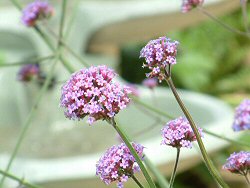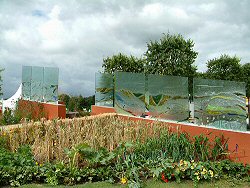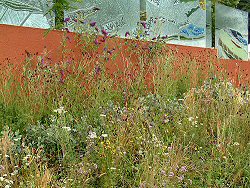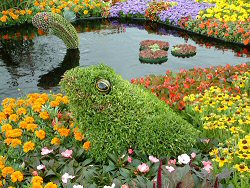Features: Flower Shows |  |
The RHS Flower Show at Tatton Park 2005 A wildife garden favourite: Verbena bonariensis. Picture by Jim McGlasson. (View bigger image.)
The 2004 Tatton Park Flower Show offered much more to the wildlife gardener than did the 2003 show: would 2005 continue the welcome trend set the previous year? As in previous years, the Royal Horticultural Society (RHS) provided SpaceForNature with a press pass but, regrettably, I was unable to attend because of other commitments. SpaceForNature was still represented at the show, however, in the shape of regular contributor Jim McGlasson. Jim went to the show on 'press day', July 19th. A wildife garden favourite: Verbena bonariensis. Picture by Jim McGlasson. (View bigger image.)
The 2004 Tatton Park Flower Show offered much more to the wildlife gardener than did the 2003 show: would 2005 continue the welcome trend set the previous year? As in previous years, the Royal Horticultural Society (RHS) provided SpaceForNature with a press pass but, regrettably, I was unable to attend because of other commitments. SpaceForNature was still represented at the show, however, in the shape of regular contributor Jim McGlasson. Jim went to the show on 'press day', July 19th.
The following short account of the show is based around the official programme of the show, the pictures taken by Jim and comments from Jim and others about the show. Whilst the account cannot be as comprehensive as in previous years, it should, at least, give a flavour of the show.
England's Northwest Garden
Each year at the Tatton show, there is a large central area called the 'Central Plaza' which is home to a substantial 'show feature' - very much like a show garden but not judged in any of the competition categories (and presumably not subject to the same restrictions).
 Central glass panels from England's Northwest Garden. Picture by Jim McGlasson. (View bigger image.)
This year's show feature on the Central Plaza was entitled 'England's Northwest Garden' and may have been the single feature of the show with most relevance to biodiversity (and by extension wildlife gardeners). Central glass panels from England's Northwest Garden. Picture by Jim McGlasson. (View bigger image.)
This year's show feature on the Central Plaza was entitled 'England's Northwest Garden' and may have been the single feature of the show with most relevance to biodiversity (and by extension wildlife gardeners).  the feature was a wonderfully successful blend of contemporary design and naturalistic planting the feature was a wonderfully successful blend of contemporary design and naturalistic planting The feature was sponsored by the Northwest Regional Development Agency. Dominated by a spectacular central feature of glass 'shards' (panels) depicting geological cross-sections of the region, the feature was a wonderfully successful blend of contemporary design and naturalistic planting. The feature was sponsored by the Northwest Regional Development Agency. Dominated by a spectacular central feature of glass 'shards' (panels) depicting geological cross-sections of the region, the feature was a wonderfully successful blend of contemporary design and naturalistic planting.
 Naturalistic planting from England's Northwest Garden. Picture by Jim McGlasson. (View bigger image.) Naturalistic planting from England's Northwest Garden. Picture by Jim McGlasson. (View bigger image.)
Surrounding the central feature were a series of plantings representing the flora of the areas shown on the glass panels adjacent to them. Among the habitats and zones represented were moorland, arable farmland, industrial heritage & urban regeneration, coastline and waterways.
More than any other garden or feature of the show, this is perhaps the one I most regret missing. The imaginative use of contemporary materials and art combined with naturalistic and inventive planting appeared to have made for a very successful and arresting garden.
The gardens
Looking through this years program, I could only find four show gardens and two back-to-back gardens that made a point of featuring wildlife gardening or very naturalistic idioms: a pretty poor showing judging by the standards of previous shows that I have attended.  Among the show gardens, 'At a Dale's Pace' and 'A Woodland Stream' featured naturalistic designs and planting whilst 'Living today with Tomorrow in Mind' and 'The Bridestone Garden' featured native or wildlife-attracting plants Among the show gardens, 'At a Dale's Pace' and 'A Woodland Stream' featured naturalistic designs and planting whilst 'Living today with Tomorrow in Mind' and 'The Bridestone Garden' featured native or wildlife-attracting plants Among the show gardens, 'At a Dale's Pace' and 'A Woodland Stream' featured naturalistic designs and planting whilst 'Living today with Tomorrow in Mind' and 'The Bridestone Garden' featured native or wildlife-attracting plants. Among the show gardens, 'At a Dale's Pace' and 'A Woodland Stream' featured naturalistic designs and planting whilst 'Living today with Tomorrow in Mind' and 'The Bridestone Garden' featured native or wildlife-attracting plants.
The two 'back-to-back' gardens,  'Through the Square Window' and 'The Butterfly Pub Garden' were the two competition gardens which explored biodiversity in most depth 'Through the Square Window' and 'The Butterfly Pub Garden' were the two competition gardens which explored biodiversity in most depth 'Through the Square Window' and 'The Butterfly Pub Garden' were the two competition gardens which explored biodiversity in most depth at the 2005 show. 'Through the Square Window' explored biodiversity in modern landscape design by including elements reflecting agricultural landscapes whilst providing a welcome for visiting wildlife like bumblebees. 'The Butterfly Pub Garden' was an out-and-out wildlife garden - as one might expect coming, as it did, from the Cheshire and Peak District Branch of Butterfly Conservation. The name of the garden was chosen to demonstrate that 'any garden can be a pub for butterflies, where they can pop in for a drink of nectar'. 'Through the Square Window' and 'The Butterfly Pub Garden' were the two competition gardens which explored biodiversity in most depth at the 2005 show. 'Through the Square Window' explored biodiversity in modern landscape design by including elements reflecting agricultural landscapes whilst providing a welcome for visiting wildlife like bumblebees. 'The Butterfly Pub Garden' was an out-and-out wildlife garden - as one might expect coming, as it did, from the Cheshire and Peak District Branch of Butterfly Conservation. The name of the garden was chosen to demonstrate that 'any garden can be a pub for butterflies, where they can pop in for a drink of nectar'.
Summary
Because I did not visit the show myself, it is difficult to compare it objectively with previous shows, nevertheless the evidence from the program and from people who did go lead me to
 Is this the kind of wildlife most likely to have beeb seen at Tatton in 2005?. Picture by Jim McGlasson. (View bigger image.)
think that biodiversity and wildlife gardening did not feature as much at Tatton in 2005 as they did at either Tatton in 2004 or Chealsea in 2005. Compare for example, the number of gardens who's descriptions from the official programmes mentioned wildlife or native wildflowers (in some way): at Chelsea 2005, the figure was eight of the 19 show gardens, whilst at Tatton 2005 the figure was only three of 19 show gardens. Is this the kind of wildlife most likely to have beeb seen at Tatton in 2005?. Picture by Jim McGlasson. (View bigger image.)
think that biodiversity and wildlife gardening did not feature as much at Tatton in 2005 as they did at either Tatton in 2004 or Chealsea in 2005. Compare for example, the number of gardens who's descriptions from the official programmes mentioned wildlife or native wildflowers (in some way): at Chelsea 2005, the figure was eight of the 19 show gardens, whilst at Tatton 2005 the figure was only three of 19 show gardens.
It all rather suggests that  last year's emphasis on 'green' and wildlife gardening may simply have reflected themes that were current or fashionable in horticultural circles at that time last year's emphasis on 'green' and wildlife gardening may simply have reflected themes that were current or fashionable in horticultural circles at that time last year's emphasis on 'green' and wildlife gardening may simply have reflected themes that were current or fashionable in horticultural circles at that time (though that doesn't explain the difference between Chelsea and Tatton this year). The challenge to gardeners and horticulturalists is to embrace gardening for biodiversity to the extent that it becomes a central tenet of gardening and not just an idiom subject to the whims of fashion. It seems that we may have some way to go yet to reach this goal. last year's emphasis on 'green' and wildlife gardening may simply have reflected themes that were current or fashionable in horticultural circles at that time (though that doesn't explain the difference between Chelsea and Tatton this year). The challenge to gardeners and horticulturalists is to embrace gardening for biodiversity to the extent that it becomes a central tenet of gardening and not just an idiom subject to the whims of fashion. It seems that we may have some way to go yet to reach this goal.
| First published August 2005. | |
Copyright Richard Burkmar 2005. Permission is hereby granted for anyone to use this article for non-commercial purposes which are of benefit to the natural environment as long the original author is credited. School pupils, students, teachers and educators are invited to use the article freely. Use for commercial purposes is prohibited unless permission is obtained from the copyright holder. |
Back to home page
Do you live in Merseyside? Interested in its wildlife? |